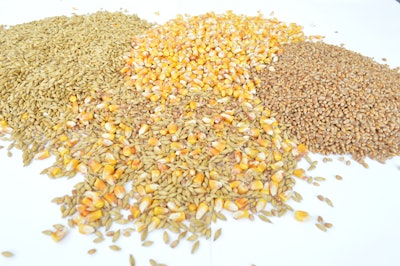
USDA's February 2022 World Agriculture Supply and Demand Estimates (WASDE) largely focused on global market conditions.
The report noted weather concerns in South America with lower soybean harvest projections for Argentina and Brazil.
This month’s U.S. soybean outlook projects increased soybean crush and lower ending stocks. Soybean crush is forecast at 2.2 billion bushels, up 25 million from last month on favorable crush margins.
The U.S. season-average soybean price for 2021/22 is forecast at $13/bushel, up 40 cents from last month, partly reflecting the impact of drought in South America.
Lower supplies and higher prices also reduce global meal demand, particularly for China.
WHEAT: The outlook for 2021/22 U.S. wheat this month is for stable supplies, lower domestic use, reduced exports, and higher ending stocks. Food use is lowered 3 million bushels to 959 million with durum accounting for the entire reduction.
The global wheat outlook for 2021/22 is for lower supplies, higher consumption, increased trade, and reduced ending stocks. Supplies are projected falling by 1.1 million tons to 1,066.3 million as reduced production more than offsets higher beginning stocks.
COARSE GRAINS: This month’s 2021/22 U.S. corn supply and use is unchanged relative to last month. The season-average farm price remains at $5.45/bushel.
Global coarse grain production for 2021/22 is projected 2.7 million tons lower to 1,497.4 million. This month’s foreign coarse grain outlook is for lower production and consumption, and smaller ending stocks relative to last month.
Foreign corn production is lower, mostly reflecting declines for Brazil and Paraguay that are partially offset by an increase for the Philippines. Brazil corn production is reduced based on lower yield expectations for first crop corn.
Paraguay corn production is down as extreme heat and dryness sharply reduce yield prospects. Foreign barley production is reduced reflecting declines for Iraq and Syria.
Major global coarse grain trade changes for 2021/22 include lower corn exports for Paraguay. For 2020/21, Argentina and Brazil’s exports for the marketing year beginning in March 2021 are raised based on observed shipments to date.
For 2021/22, corn imports are raised for Iran and Canada. Barley exports are increased for the EU, with higher imports projected for China but lowered for Saudi Arabia. Foreign corn ending stocks are down, mostly reflecting a forecast reduction for Brazil that is partly offset by an increase for Argentina. Global corn stocks, at 302.2 million tons, are down 0.9 million.
OILSEEDS: This month’s 2021/22 U.S. soybean outlook is for increased soybean crush and lower ending stocks. Soybean crush is forecast at 2.215 billion bushels, up 25 million from last month on favorable crush margins and improving prospects for soybean meal exports.
Soybean meal exports are reduced for Argentina, Brazil, and Paraguay as drought-reduced crops limit crush prospects. With soybean exports unchanged, ending stocks are reduced 25 million bushels to 325 million.
The U.S. season-average soybean price for 2021/22 is forecast at $13/bushel, up 40 cents from last month partly reflecting the impact of drought in South America. The soybean meal price is forecast at $410 per short ton, up $35. The soybean oil price forecast is raised 1 cent to 66.0 cents per pound.
Global 2021/22 soybean supply and demand forecasts include lower production, crush, exports, and stocks. Global soybean production is reduced 8.7 million tons to 363.9 million on drought in South America. Brazil’s soybean crop is lowered 5 million tons to 134 million, Paraguay is lowered 2.2 million to 6.3 million, and Argentina is reduced 1.5 million to 45 million. Exports and crush are lowered in all three countries.
Lower supplies and higher prices reduce global meal demand, particularly for China where soybean crush and imports are lowered 3 million tons to 94 and 97 million, respectively.
Global soybean ending stocks are reduced 2.4 million tons to 92.8 million. Another notable oilseed change includes a 1.3-million-ton increase to 10.8 million for Indian rapeseed production on a faster-than-expected planting pace and higher yields.

















